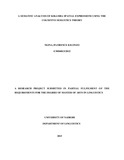| dc.description.abstract | The primary concern of this study is the semantic meanings of Kikamba spatial expressions. The main focus of this study is the semantic analysis of Kikamba spatial demonstratives and prepositions within the framework of the cognitive semantics approach. The main sources of the data used in this study were a Kikamba authentic text on the cultural practices of the Kamba people by Kimilu and a dictionary by Mwau . In addition, the researcher obtained relevant data from interactions with other native speakers of Kikamba. Data collection involved getting words from the said texts in form of demonstratives and prepositions as well as checking their validity from the Kikamba dictionary. Their spatial orientation is analysed. Special interest is given to the underlying co ordinates of the analysed Kikamba spatial prepositions in the intrinsic frame of reference. More data in Kikamba spatial prepositions is further analysed in relation to body sidedness and absolute frames of reference. All the data is given a semantics analysis using the concept of frames of reference. Later, this analysis of the data is followed by a summary of findings, conclusion, recommendations and suggestions for further research in related areas. In the findings of this study Kikamba is a mixed system in respect to the concept of the frames of reference. Kikamba uses object sidedness (intrinsic frames of reference) as in “Mwaitũ e ng‟oko wa kĩĩma” (mother is over the hill). The figure – mwaitu - takes orientation from an object in this case the hill. Kikamba also uses bodily sidedness as in “Wavika musyi muunda wi kwokoni kwa aka” (when you get home the garden is to the left hand side). Here the point of view uses a body part, the left hand, to assign co ordinates to the figure – mũũnda. Kikamba also uses absolute frames as in “Malondu meelekela ũthũĩlonĩ wa sua” (The sheep are headed west). In this case the projection of the figure and ground are external and determined by fixed co ordinates abstracted from the solar system. | en_US |

